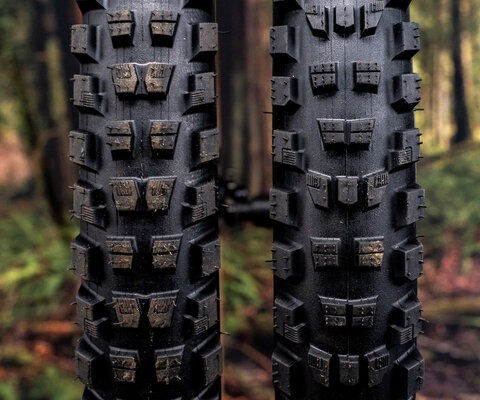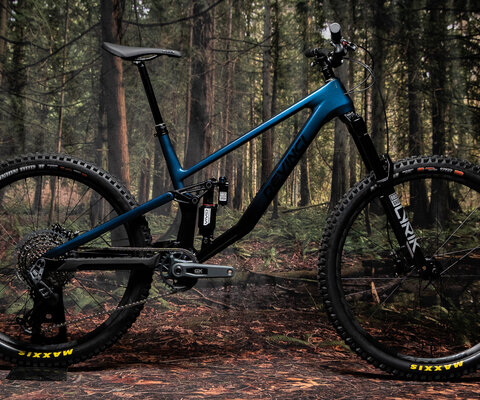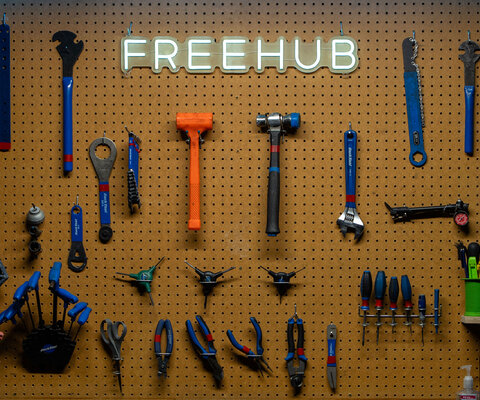
No Place Like Home Affordable Housing Problems Grow Amid the American Mountain Biking Boom
Words by Jess Daddio
Chad Cornish doesn’t want to leave Colorado’s Roaring Fork Valley. Originally from upstate New York, Chad, 34, moved to the valley 10 years ago. Back then he was a skier, and what better place for a skier to live than the base of Aspen and Snowmass Mountains? But when he rode Government Trail for the first time, he saw a Roaring Fork Valley beyond the resorts, one that was “tough, beautiful, desolate.”
The Roaring Fork Valley is one of only six gold-level International Mountain Bicycling Association (IMBA) Ride Centers in the world. With over 300 miles of singletrack in the valley between Aspen and Glenwood Springs, Chad has no shortage of trails to ride. Life in the valley is pretty sweet. It’s where Chad settled down with his wife, started their family, built singletrack for the county, and taught his daughter to ride a bike. But Chad often feels cynical about the current state of housing in the valley, especially where he lives in Aspen. It was expensive before the pandemic. Now, even condos cost an average $2.5 million.
Tourism-related housing pressures are nothing new—ski resort areas such as Aspen have struggled for decades to provide workforce housing. The difference now, says economist Megan Lawson, is that a town doesn’t need a multimillion-dollar ski resort to feel the housing squeeze; a good trail system can be enough to tip the scale.
Lawson’s research for the nonprofit think tank Headwaters Economics shows that even before the pandemic-fueled exodus of Americans from big cities, people with higher incomes were already moving to recreationally rich (and often rural) counties at a higher rate than counties without recreation. In 2020, Lawson’s research found that the cost of housing in these communities was higher than places that didn’t have recreation, while the local wages were lower.
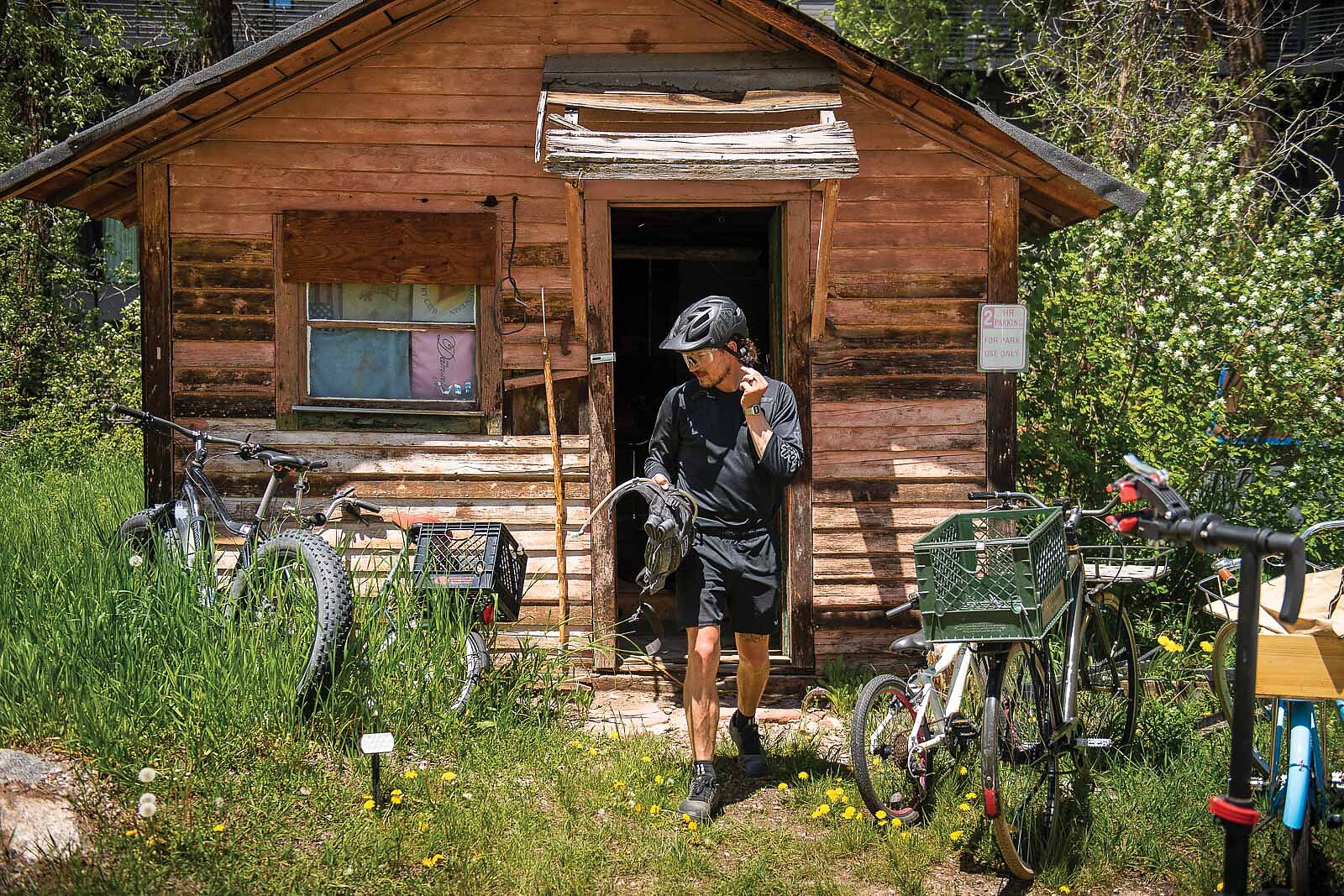
“Then some influencer takes a photo or someone writes an article, and then lo and behold the things they hoped for, the gremlin they fed, becomes a full-grown monster.”—Jake Powell
“It’s a symptom of success,” Lawson says. “If [your trails] are successful, you will have unaffordable housing. The pandemic took those trends that we were seeing prior and just threw gasoline on the fire.”
More communities are putting trails on the ground every day, which can bring a host of benefits to rural areas in particular. Aside from the immediate improvement to quality of life for locals, trails attract new residents—real human capital—which helps replenish diminishing populations, revitalize economies, create jobs, build more trails, and inject much-needed dollars in places that have suffered from years of disinvestment.
But that progress can and does have unintended consequences, says Jake Powell, an assistant professor in Landscape Architecture and Environmental Planning at Utah State University. Powell leads the university’s Gateway and Natural Amenity Region (GNAR) Initiative. GNAR provides resources for “gateway” recreation communities in the Intermountain West that are grappling with those challenges, be it traffic congestion, labor shortages, housing affordability, or income inequalities.
“This is sort of the dark side of this love affair that we all have with these gateway communities,” Powell says. “Most of the communities we’re watching are planning after the tidal wave has washed upon the shore. They build the trails and no one shows up, then some influencer takes a photo or someone writes an article, and then lo and behold the things they hoped for, the gremlin they fed, becomes a full-grown monster. The monster is alive and breathing and running amuck and it’s really hard to cage it after the fact.”
For decades, mountain bikers have been on a crusade to legitimize trails, extolling the many socioeconomic gains trails can bring to communities, especially those in rural America. By now, many of those benefits have been realized. But as trail town housing pressures continue to intensify, many locals are finding themselves unable to afford living in their hometowns.
“The worst-case scenario is these places become playgrounds for the wealthy,” Lawson says. “I’m not pessimistic. People don’t give up.”

For the past four years, Chad has rented from the Aspen/Pitkin County Housing Authority, or APCHA. Developed in 1982, APCHA is the oldest and largest mountain resort workforce housing program in North America. The 3,122 units are for those with low, middle, and moderate incomes who both live year-round and work full-time in the city of Aspen or Pitkin County.
Roaring Fork Mountain Bike Association (RFMBA) Executive Director Mike Pritchard believes APCHA housing is a crucial part of making Aspen a livable community. The city currently has some 300 more APCHA units in development, but plans for other projects down the valley have failed due to “not in my backyard,” or NIMBY, sentiment against high density housing. For Pritchard, finding employees for RFMBA’s paid seasonal trail crew positions has become more difficult, specifically because potential employees are required to find housing before they accept the job offer.
“The free-market economy makes it really challenging to have a low-paying job like a seasonal trail worker and to live kinda close to where the work is,” Pritchard says. “If we want to have people serving uscoffee or taking care of our trails, we need to figure this out.”
Gary Tennenbaum is the Director of Pitkin County Open Space and Trails, a tax-payer-funded program that purchases and manages open space to build trails, preserve agriculture, and protect wildlife habitat. The lack of workforce housing is one of the reasons Open Space and Trails started renovating some dilapidated buildings it acquired to turn them into housing for staff and agricultural lessees. Open Space and Trails currently rents to five people and follows APCHA guidelines for determining income-based rent. While the housing helps, Tennenbaum doesn’t see employer-provided housing as a viable solution to the housing crisis in Pitkin County.
“We don’t want to become a big landlord,” Tennenbaum says. “When we purchase properties, we don’t look for properties that have housing. That’s not really our mission.”
Tennenbaum says the challenges of expanding more attainable housing in Pitkin County are exacerbated by the fact that roughly 80 percent of the land in the county is federal public lands. Couple that with the Roaring Fork Valley’s topography, a river valley boxed in by 14,000-foot peaks, and the amount of land that’s developable gets even smaller. Some lawmakers in Colorado have proposed legislation that would allow the acquisition of public lands for the development of workforce housing. There’s already a precedent for this in Nevada, the Southern Nevada Public Lands Management Act, which allows the sale of Bureau of Land Management (BLM) land to fund recreation infrastructure projects. The City of Las Vegas recently purchased over 900 acres of BLM land for a housing project, although the specifics of that development have not yet been released. Chad is not a fan of the idea.
“I 100 percent care more about the environment than me being here,” Chad says. “I’d rather leave the valley than start taking over BLM or national forests.”
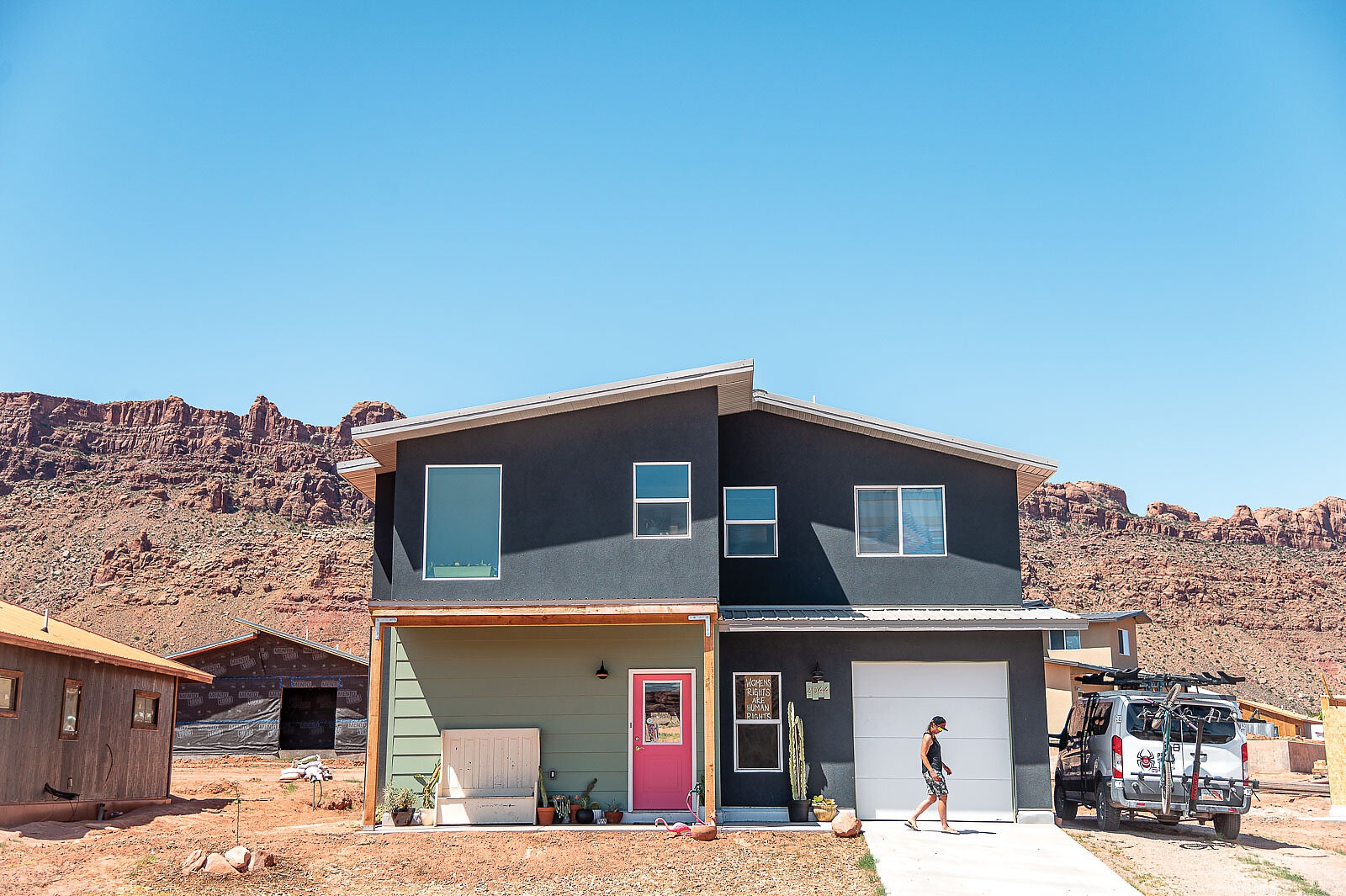
Like Aspen, most land in and around Moab, Utah is state or federally owned. It is the literal gateway to Arches and Canyonlands National Parks, Dead Horse Point State Park, and Manti-La Sal National Forest. Moab’s entire economy depends on recreational tourists, from Jeepers to base jumpers. Mountain bikers are especially fond of Moab’s rugged, red rock landscapes. A 2022 study commissioned by the Outdoor Alliance found that mountain bikers visiting the Manti-La Sal supported 140 jobs and $4.3 million in wages in Moab.
As Moab’s popularity has exploded, so too has its cost of living. Moab has always had a shortage of housing stock, a problem that dates back to the town’s uranium mining days. When Moab Area Community Land Trust (MACLT) Executive Director Kaitlin Myers moved to Moab in 2016, the median sales price of a house in Grand County was $294,000. By March 2022, it had jumped to $700,000. Average rent for a three-bedroom unit is $2,100, but long-term rentals are increasingly hard to come by.
“To address the housing crisis you have to take multiple approaches all at once,” Myers says. “There’s never going to be a silver bullet.”
The City of Moab continues to build small affordable housing projects, but progress is slow and expensive. In 2018, the city bought a trailer park with the intent to develop it into an 80-unit multifamily housing complex, but construction has still not started. In 2019, the city passed a moratorium on all new construction of overnight rentals. That same year, Grand County passed a High Density Housing Overlay, which offers a density bonus in exchange for 80 percent of new units being deed-restricted for locals working in the county. In 2022, the county passed an Alternative Dwelling Overlay, which essentially legitimizes property for van life and RV use. Even Moab employers, like Western Spirit Cycling, are taking housing matters into their own hands by building employee housing for its mostly seasonal staff.
After a decade of floating between trailers and rentals, Whole Enchilada Shuttle Company owner Samantha Derbyshire finally has a home of her own thanks to a partnership between MACLT and the Housing Authority of Southeast Utah. Derbyshire is one of the first homeowners at Arroyo Crossings, a 41-acre project owned by the trust that will eventually have 300 units for residents of Grand County with low and moderate incomes. Through the Housing Authority, Derbyshire was able to take advantage of the USDA’s Mutual Self-Help Housing program, which provides low-income households with a low interest rate loan and often no down payment. The catch? The homebuyer must clock sweat equity on their homes.
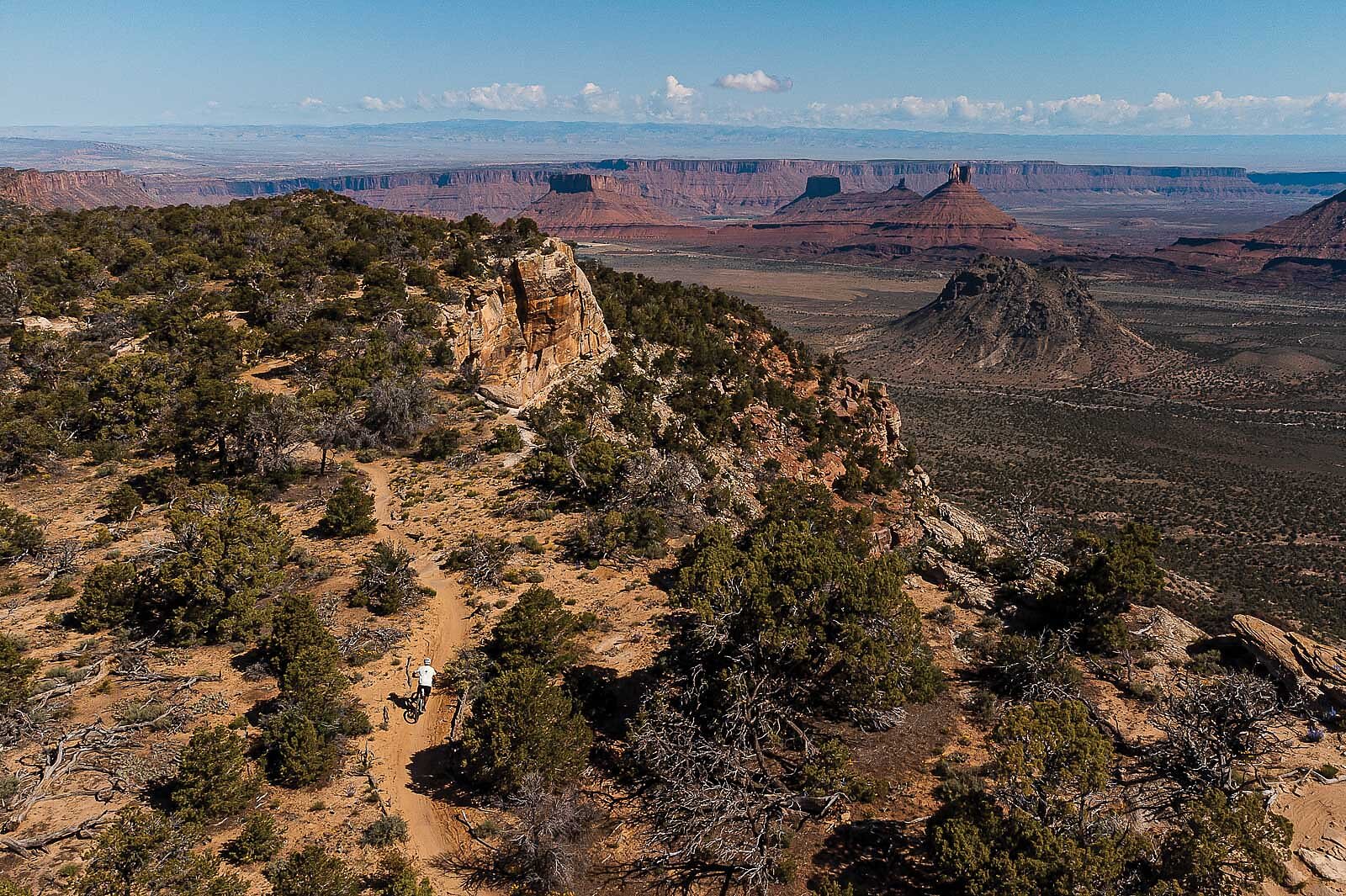
“Once you lose the people that live in your community, you lose the soul of your community and there’s no way you can get it back.”
For nearly 10 months, Derbyshire put in the required 30-hours-per-week minimum of work on her house. It was one of the most exhausting periods in her life. When she wasn’t working on the house, she was working more than 40 hours a week as a shuttle driver and a waitress just to make ends meet.
“It’s the only way you can afford a house in Moab unless you’re independently wealthy or your parents buy it for you,” Derbyshire says. “It’s a great program but it’s not going to work for people that don’t have the time to build. It’s basically a full-time job.”
Another pitfall of the program is that some of Moab’s working class make too much to qualify for affordable housing, but still don’t make enough to buy anything on the market. Courtney Kizer is an architect, developer, and mountain biking coach in Moab. For the past five years, Kizer and her husband have been building Murphy Flats, a 37-unit condominium development that will provide housing for that “missing middle.” The units are deed-restricted for primary residency and active employment but not income. Kizer notes that it’s difficult to build housing for the middle class because the federal government only provides subsidies and tax breaks for developers of low-income housing. Incentives are needed for middle income housing, too.
“Developers are not the enemy,” Kizer says. “They are the ones with the resources and the tools to build the housing we need.”
Myers believes communities like Moab need to be thinking proactively about housing solutions, not retroactively, especially if they are building trails to draw tourists. Moab’s tourism contributes to its housing crisis, although it’s difficult to quantify exactly how much of a role mountain bikers play. Still, she thinks it’s crucial for towns to build any kind of infrastructure, recreation or otherwise, with a workforce-first mindset. When Myers first moved to Moab, she remembers someone told her, “Once you lose the people that live in your community, you lose the soul of your community and there’s no way you can get it back.”
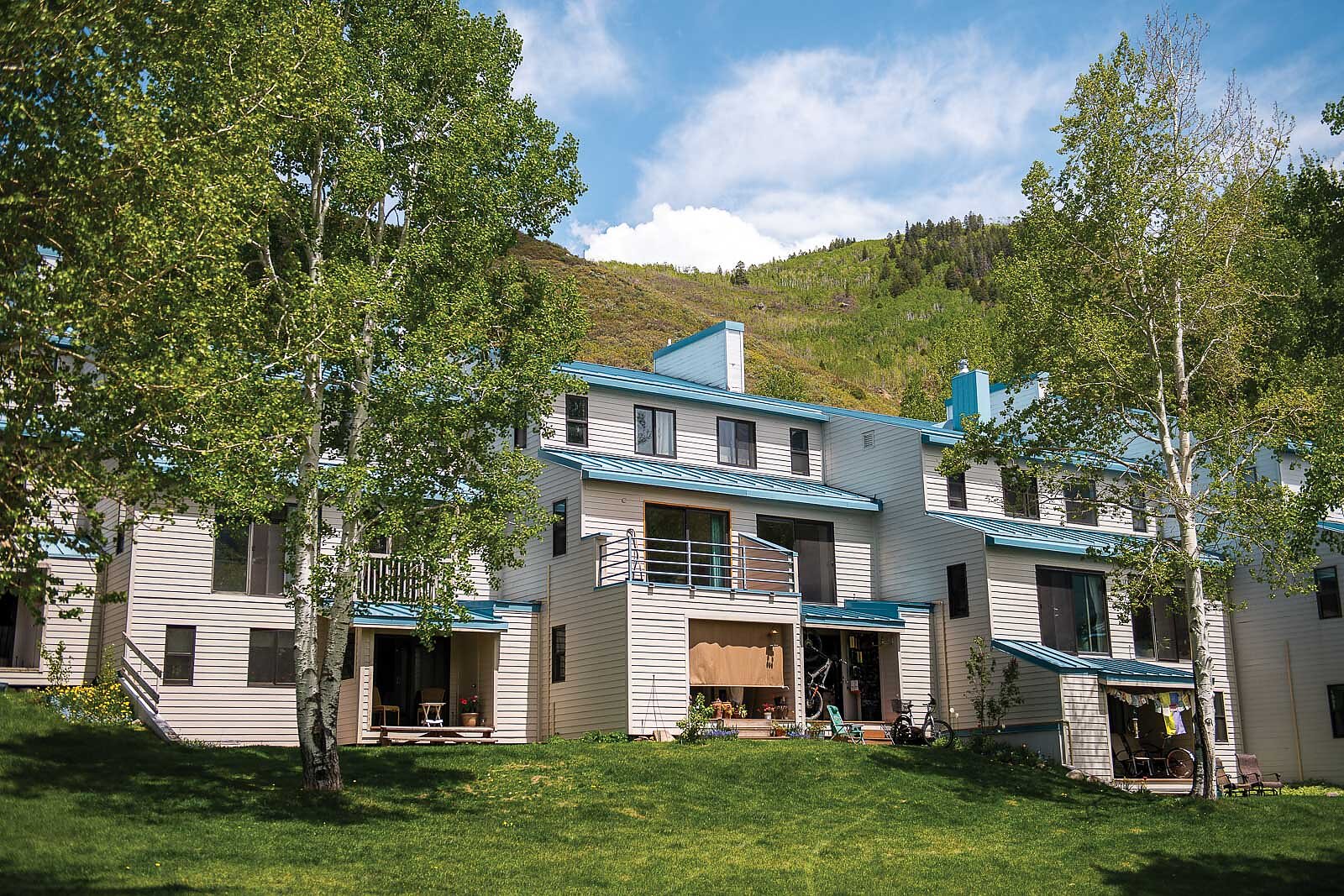
Old Fort does not want to lose the soul of its community. That’s why the 800-person-strong western North Carolina town is thinking holistically when it comes to equitable trail development. At the heart of their trail plan is Old Fort’s Black community, which makes up more than 30 percent of the town’s population. Unlike the vast majority of trail plans, Old Fort’s project doesn’t just promise economic development; it leverages trails to garner community investment, ensuring that the town’s most marginalized residents actually benefit from the trail infrastructure. Accomplishing that, however, is easier said than done.
About 25 miles east of Asheville, at the Black Mountains’ doorstep in Pisgah National Forest, Old Fort is in a prime position to become a mountain bike destination. In addition to classic Pisgah singletrack like Kitsuma Trail and Heartbreak Ridge, Old Fort will soon have 42 miles of new multi-use trail in the national forest. Spearheaded by the Catawba Vale Collaborative (CVC)—a community-first partnership including Camp Grier and its nonprofit G5 Trail Collective, the nonprofit Eagle Market Streets Development Corporation (EMSDC), the Black-led community organization People on the Move for Old Fort, and the U.S. Forest Service Grandfather Ranger District—the trails have been embraced by the community as a means of economic revitalization.
So far, the CVC has been successful at building trails and addressing community needs in tandem. The Dogwood Health Trust awarded the G5 Trail Collective $490,000 to build the first six miles of trail. The trust additionally awarded EMSDC $289,000 to purchase a co-working and business incubator space to support Old Fort’s entrepreneurs of color. Even so, the CVC is not naive to the dark side of trails. They know that increased trail use brings money, which can be good for spurring economic activity but if not harnessed equitably, can also push out the most vulnerable of their community members. McDowell County’s poverty rate is 14.5%, a higher percentage than both North Carolina and U.S. poverty levels (13.4% and 11.6% respectively, according to 2021 estimates by the U.S. Census Bureau). So, in 2022 when 11 acres of land in a historically Black stronghold of Old Fort went up for sale at a tax auction, the CVC worried.
“We were like ‘OK, this is how it begins,’” Jason McDougald says, who works as the executive director of Camp Grier and the G5 Trail Collective. “This is how gentrification starts.”
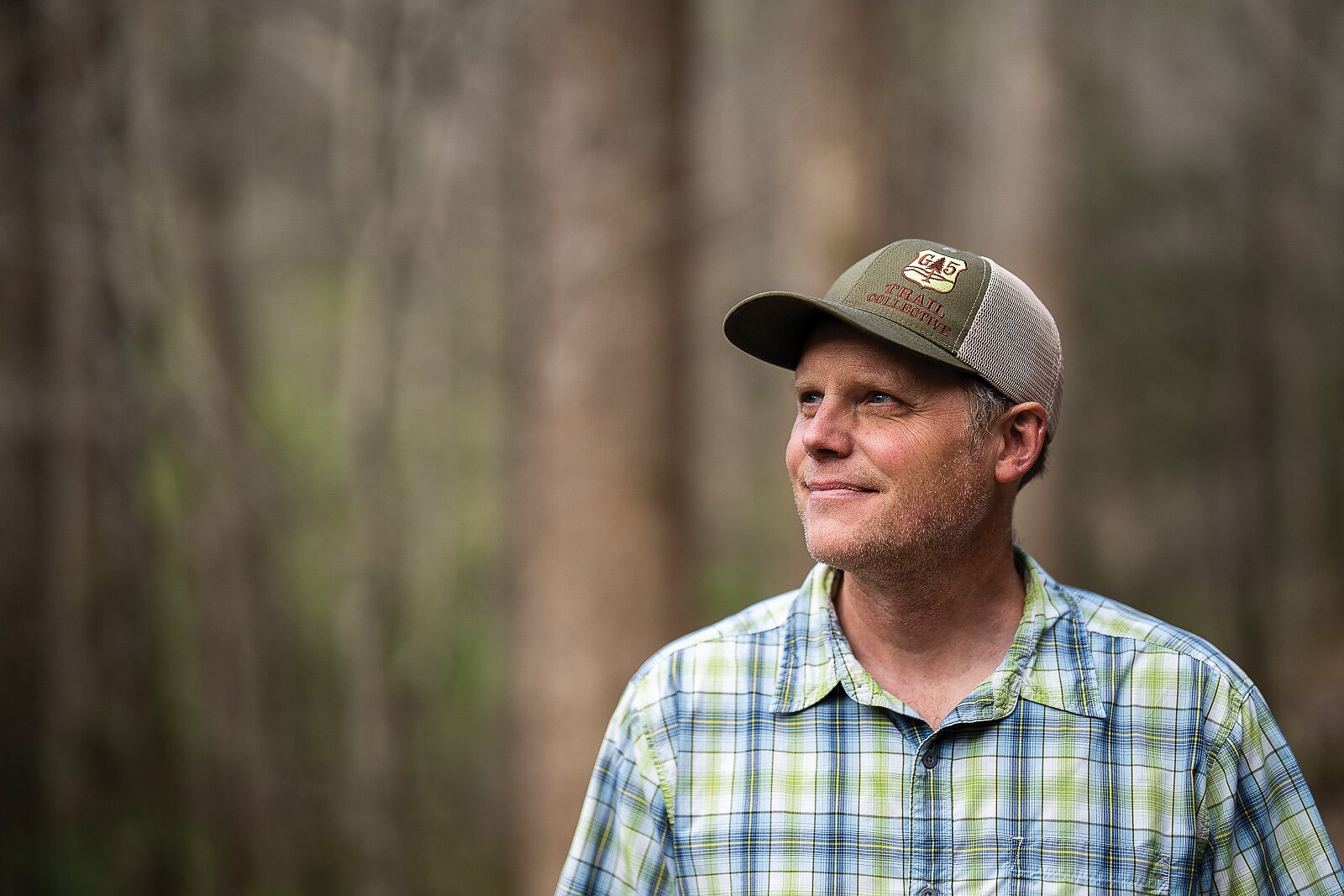
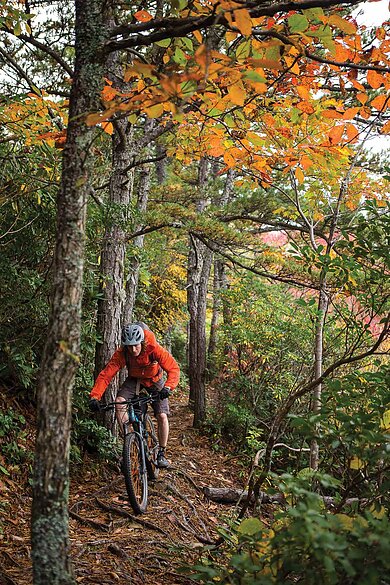
The CVC scrambled to find philanthropic capital to keep the land out of outside interests’ hands. While they didn’t find the funds to purchase the property themselves, they were able to get it off the market thanks to People on the Move for Old Fort, which purchased three acres, and a local benefactor, who purchased the remaining eight and agreed to hold the property until CVC could secure the money to buy it. CVC plans to build affordable housing on the property, but without flexible philanthropic funds that can be deployed quickly, the collaborative is limited in its capacity not just to build trails but to build community buy-in.
“The challenges are numerous, especially in a rural town with a developing economy,” McDougald says. “It’s a chicken and the egg kinda thing. People aren’t going to invest in workforce housing unless they know the jobs are there, but a lot of times in an outdoor recreation economy, once the jobs are there you’ve lost the housing battle.”
The crux, of course, with building trails and workforce housing, is finding the money—and lots of it. Trails are cheap compared to workforce housing. The CVC estimates it will need another $3 million to complete the remaining 36 miles of trail. Building a housing project, however, can take tens of millions of dollars. And for a rural community with less than 1,000 people, that feels like an enormous and unattainable sum.
“Due to redlining and disinvestment in communities both rural and of color, the hurdles are large to tackle issues of today never mind issues of thefuture,” Stephanie Swepson Twitty says, EMSDC’s CEO. “Having a complete funding ecosystem with private, public, and philanthropic dollars is how we’re really going to be able to move this thing forward in a positive way.”
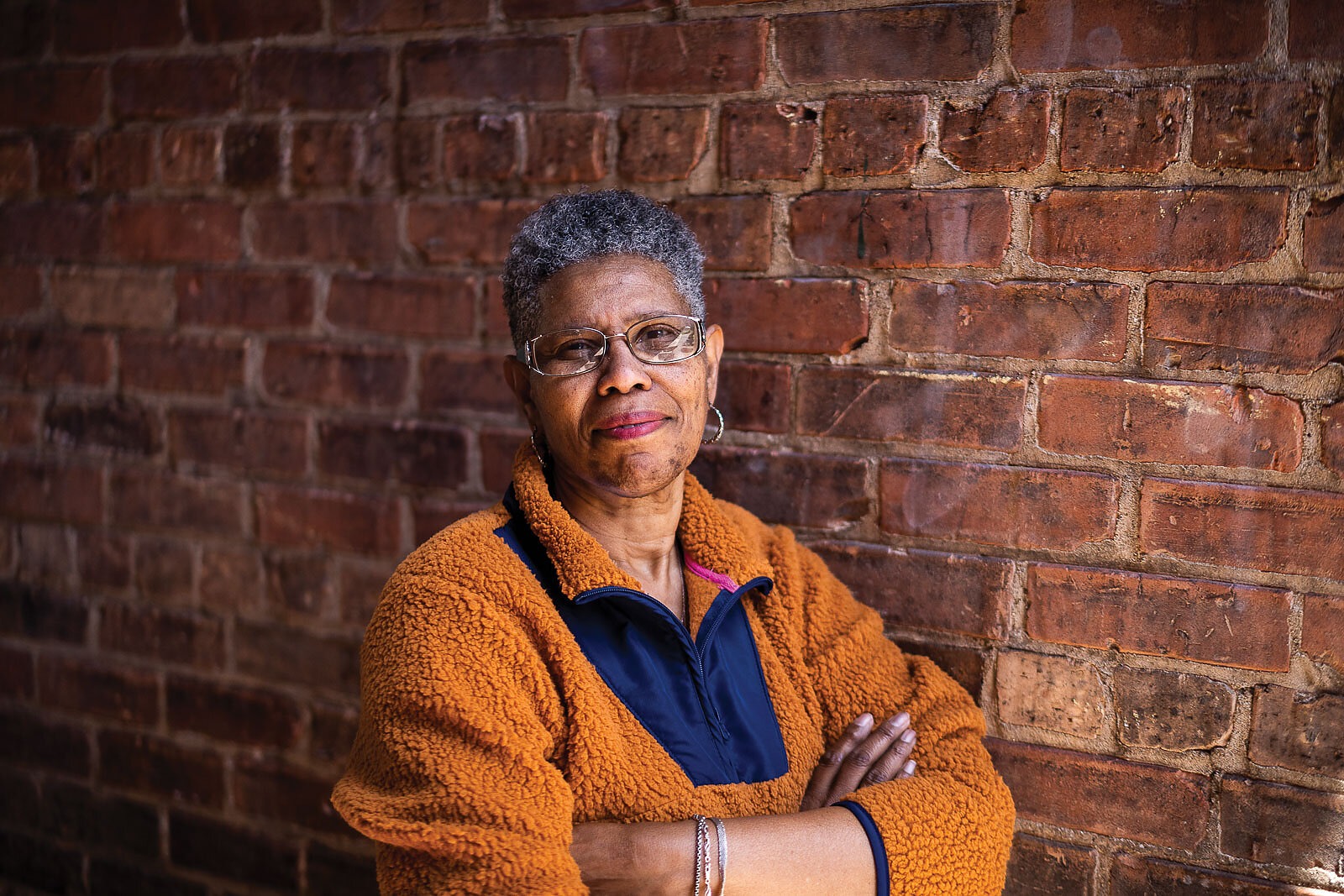
Brian Hann is not convinced Knoxville’s Urban Wilderness (KUW) trail system is having a negative impact on housing. Hann is, among other things, a general contractor, one of the original visionaries for the KUW, the former president of the Appalachian Mountain Bike Club (AMBC), and somewhat of a real estate kingpin in south Knoxville, where the majority of the city’s trails are located.
Around 2012, Hann started strategically buying property throughout south Knoxville for the express purpose of connecting city parks with singletrack. Back then, a single-family home in south Knoxville might have cost $50,000 or less. The area had suffered from years of disinvestment compared to downtown and parts of the city on the other side of the Tennessee River. Part of that was due to the steep and rocky terrain. What was ill-suited for building housing turned out to be great for building trails. As AMBC started putting more trail on the ground, interest in south Knoxville real estate grew. On every property he bought, Hann created an easement for trail access, slowly expanding connectivity mile by mile.
“We’ve been importing trail-friendly folks for years,” says Matthew Kellogg, AMBC’s executive director. Hann helped Kellogg find property in south Knoxville, a former chop shop on a 20-acre lot that now provides an easement to the present-day Transfarm trail. “I found my neighbors, all of them, because ultimately, self-servingly, I want this network to grow.”
Today’s roughly 50-mile KUW system connects five public parks via more than 400 acres of private property owned by 14 different landowners, including Hann and Kellogg. Kellogg and his trail-friendly neighbors affectionately call their corner of south Knoxville “The Commune.” In a way, this unofficial collective of landowners is the epitome of community buy-in and a real-world case study in how trails benefit more than mountain bikers. Without the KUW, it’s plausible that many of the neighborhoods in south Knoxville would have been mowed over by an extension of the James White Parkway. (The city killed the highway proposal in 2013, citing the KUW’s positive impact on quality of life).
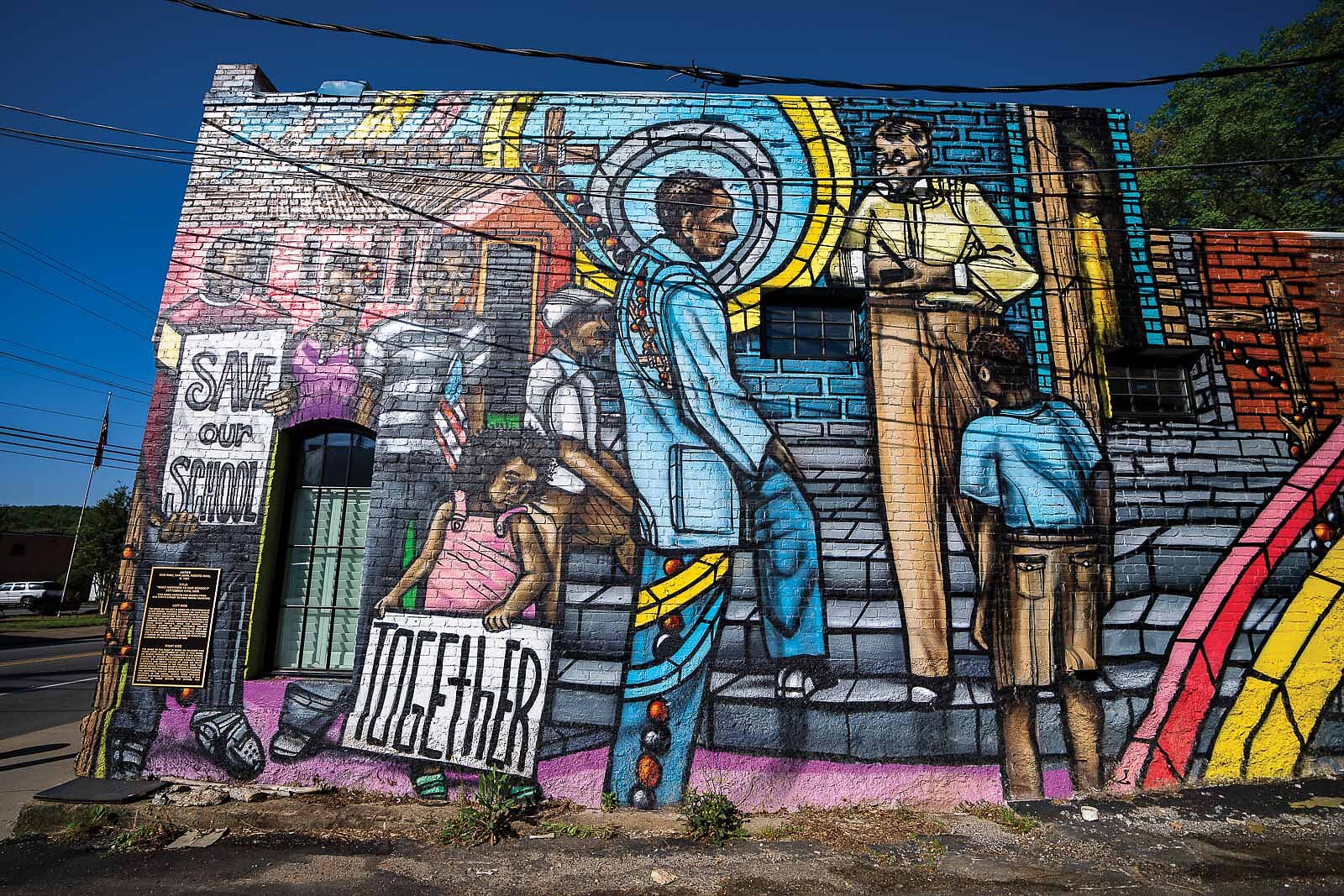
But like everywhere else in the country, property values throughout Knoxville soared during the pandemic. Anecdotally, Kellogg says a number of mountain bikers have recently moved to south Knoxville and were willing and able to pay the premium for having a house near the KUW.
“South Knox is one of the hottest real estate markets right now,” says Kevin DuBose, Knoxville’s Director of Housing and Neighborhood Development. To some, it begs a question: Is the KUW trail system accelerating gentrification?
“The desire to live around a trail system I think does drive up home prices to a certain extent,” Hann says. “But I think it’s a byproduct of good quality of life anywhere, whether it’s trails or good schools. Homes are usually your single biggest investment. When you have to sell your house, don’t you want it to be worth a lot more than when you bought it? That’s kinda the point.”
A 2022 study published by the University of Tennessee analyzed the very question of whether the KUW promoted gentrification, ultimately concluding that the data was inconclusive. Dr. Charles Sims is the Director of the Energy and Environment Program at the university’s Howard H. Baker Jr. Center for Public Policy. Sims co-authored the study, which was based on pre-pandemic data from 2017. Sims, it is worth mentioning, was born and raised in south Knoxville, is a mountain biker, and owns property in The Commune. He says a post-pandemic follow-up to the study is needed to better understand the perceived effects of trail access on south Knoxville real estate. Even so, it is difficult to differentiate whether increased property values have been a result of trail development or development in other parts of the city such as downtown and along the waterfront.
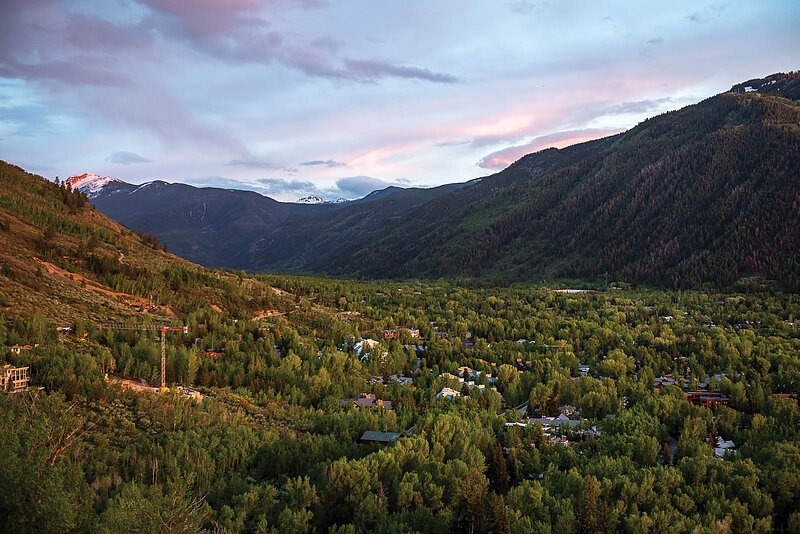
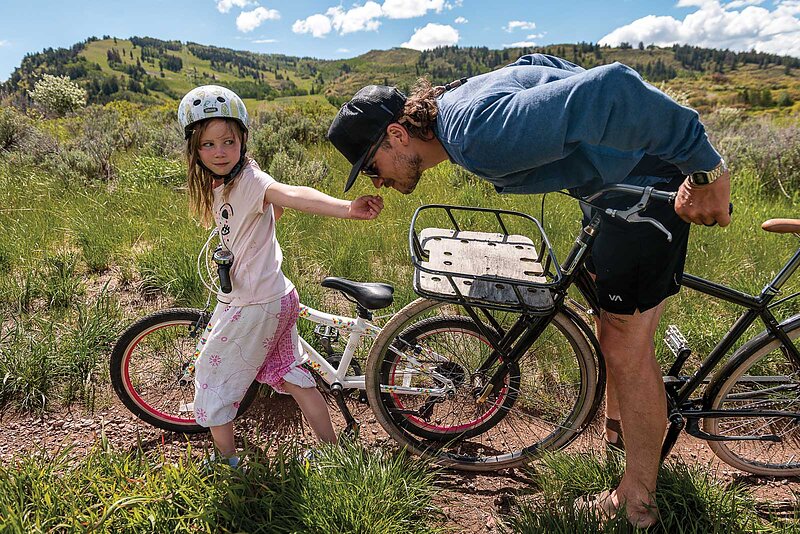
“I do want to push back against that notion that just because a neighborhood is changing its socio-demographics, that that’s necessarily a bad thing,” Sims says. “I think where it becomes problematic in my mind is when those people are involuntarily forced out.”
Back in Aspen, Chad Cornish knows exactly where he and his family would be without access to APCHA housing: “Gone.”
Never mind that he thinks Government Trail is “literally the best trail in the world,” or that his most treasured moments with his daughter have been on the streets of Aspen where she learned to change gears on her bike. Chad understands that the backdoor recreation that he holds so dear could be the very thing that keeps him from staying in the valley long term.
“If I ever have to look for housing, I’m just not going to do it. It’s unfeasible. I would most likely leave the valley,” Chad says. “As much as I love mountain biking here, I could buy land in upstate New York and build my own trail system. You want the security that you have a place to live forever, ya know?”
